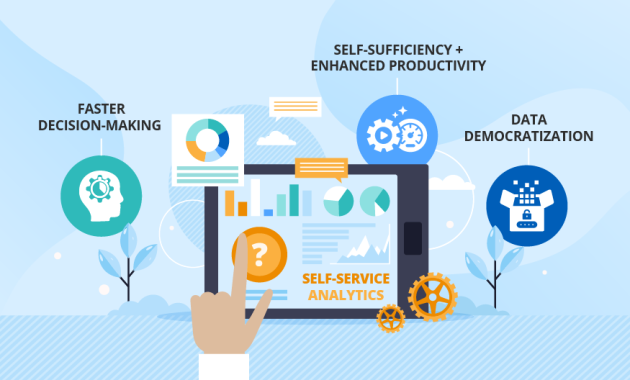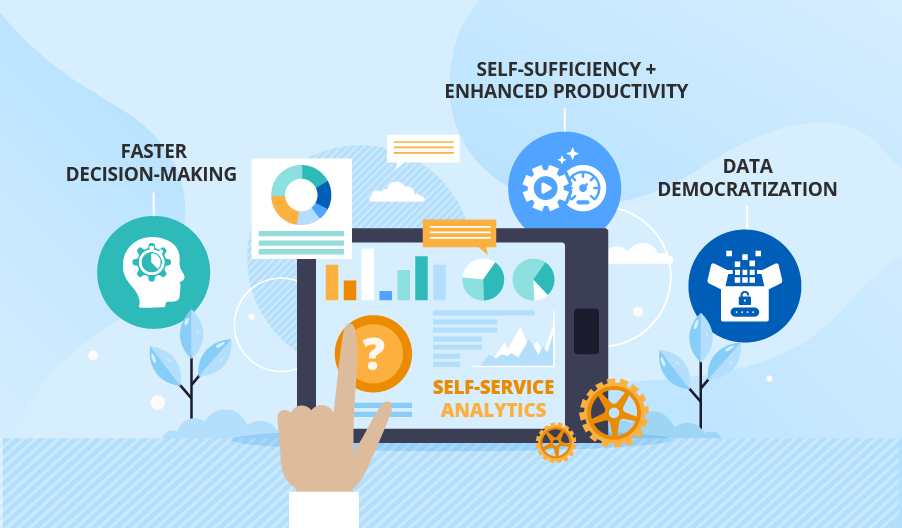
Cut Delays with Self-Service Business Intelligence Software: A Guide to Faster Insights
In today’s fast-paced business environment, the ability to make quick, data-driven decisions is critical. Waiting weeks or even days for reports and insights can be crippling. This is where self-service business intelligence (BI) software comes in. It empowers business users to access, analyze, and visualize data without relying on IT or data science teams. This article explores how self-service business intelligence software can help you dramatically cut delays and accelerate your decision-making processes.
The Bottleneck of Traditional BI
Traditional BI often involves a complex, multi-step process. Requests for data analysis go through IT departments or specialized data teams. These teams then extract, transform, and load (ETL) data. They create reports and dashboards. This can be time-consuming. It creates significant delays. The bottlenecks are often the result of limited resources. There can also be communication challenges between business users and technical teams. This creates a cycle of request, wait, and revision. This cycle slows down the entire process.
The traditional BI process is not always responsive to the dynamic needs of the business. By the time a report is delivered, the initial questions may have shifted. The market may have changed. This renders the insights obsolete. It also leads to missed opportunities. It can lead to poor strategic decisions. This outdated approach is simply not sustainable in a competitive landscape.
The Power of Self-Service BI
Self-service business intelligence software offers a radically different approach. It puts the power of data analysis directly into the hands of business users. This allows them to explore data, create reports, and build dashboards. They do so without needing extensive technical expertise. Key features of self-service BI include:
- Intuitive Interface: User-friendly interfaces with drag-and-drop functionality. This simplifies data exploration and report creation.
- Data Connectivity: The software connects to various data sources. These may include databases, spreadsheets, and cloud services.
- Data Visualization: Powerful visualization tools. They transform raw data into easy-to-understand charts and graphs.
- Data Preparation: Features to clean, transform, and prepare data for analysis.
- Collaboration: Built-in features for sharing insights and collaborating with colleagues.
This empowers users. It increases agility. It allows business users to quickly answer their own questions. They can also make decisions based on the most current data. This leads to a faster and more responsive organization.
Key Benefits of Cutting Delays with Self-Service BI
Implementing self-service business intelligence software brings several significant benefits. These benefits directly address the inefficiencies of traditional BI. They contribute to faster decision-making and improved business outcomes.
Faster Insights
The most obvious benefit is the speed at which insights are delivered. Instead of waiting for weeks, users can generate reports and dashboards in minutes or hours. This allows them to quickly identify trends, patterns, and anomalies. They can then take immediate action.
Improved Decision-Making
With faster access to data, decisions can be based on the most current and accurate information. This reduces the risk of making decisions based on outdated or incomplete data. This leads to better decisions. These decisions are more aligned with business goals.
Increased Agility
Self-service BI allows businesses to respond quickly to changing market conditions. Users can quickly adapt their analysis to address new challenges and opportunities. They can also pivot strategies as needed. This flexibility is critical for staying competitive.
Reduced Costs
By empowering business users, self-service BI reduces the workload on IT and data science teams. They can focus on more complex tasks. This frees up resources. It also reduces the need for external consulting services. This can lead to significant cost savings.
Enhanced Collaboration
Many self-service BI tools include features for collaboration and data sharing. This allows teams to work together more effectively. They can share insights and build consensus around data-driven decisions.
Choosing the Right Self-Service BI Software
Selecting the right self-service business intelligence software is crucial for success. Consider these factors when evaluating different options:
- Ease of Use: The interface should be intuitive and easy to navigate. Look for drag-and-drop functionality.
- Data Connectivity: Ensure the software connects to your existing data sources. This includes databases, spreadsheets, and cloud services.
- Data Visualization Capabilities: The software should offer a wide range of visualization options. This includes charts, graphs, and dashboards.
- Data Preparation Features: Look for tools that allow you to clean, transform, and prepare your data.
- Scalability: The software should be able to handle increasing data volumes and user demands.
- Security: Ensure the software has robust security features to protect your data.
- Cost: Consider the pricing model. Also, consider the total cost of ownership.
- Support and Training: Check for available support and training resources. This ensures users can effectively utilize the software.
Implementing Self-Service BI: Best Practices
Successfully implementing self-service business intelligence software requires careful planning and execution. Follow these best practices:
- Define Clear Goals: Identify specific business problems you want to solve. Define the key performance indicators (KPIs) you want to track.
- Choose the Right Software: Select software that meets your specific needs. Consider the factors mentioned above.
- Provide Training and Support: Train users on how to use the software effectively. Offer ongoing support to address questions and issues.
- Establish Data Governance: Implement data governance policies to ensure data quality and consistency.
- Promote Data Literacy: Encourage a data-driven culture within your organization. Promote data literacy among all employees.
- Start Small and Scale: Begin with a pilot project. Then, gradually expand the use of the software across your organization.
Real-World Examples of Cutting Delays
Many companies have successfully cut delays and improved their decision-making processes. They have done so by implementing self-service business intelligence software. Here are a few examples:
- Retail: A retail chain uses self-service BI to track sales data in real-time. This allows them to quickly identify slow-moving products. They can then adjust their inventory and pricing strategies accordingly.
- Healthcare: A hospital uses self-service BI to monitor patient outcomes and identify areas for improvement. This enables them to improve patient care. They can also optimize resource allocation.
- Manufacturing: A manufacturing company uses self-service BI to track production efficiency. They can identify bottlenecks and optimize their manufacturing processes. This increases throughput.
- Finance: A financial services firm uses self-service BI to monitor customer behavior. They can also identify fraud and improve customer service.
These examples demonstrate the versatility and impact of self-service BI across different industries. The ability to quickly access and analyze data is a key differentiator.
Overcoming Challenges
While self-service BI offers significant benefits, it is important to be aware of potential challenges. These include:
- Data Quality: Ensuring the accuracy and consistency of data is crucial. Implement data governance policies.
- User Adoption: Encourage user adoption through training and support. Highlight the benefits of using the software.
- Data Security: Implement robust security measures to protect sensitive data.
- Data Silos: Integrate data from different sources to avoid data silos.
- Lack of Expertise: Provide adequate training and support to users. This helps them develop the necessary skills.
By addressing these challenges proactively, you can maximize the success of your self-service BI implementation.
The Future of Self-Service BI
The trend toward self-service business intelligence software is expected to continue. Advancements in technology are making it even more accessible and powerful. We can expect to see:
- Increased Automation: Automation will simplify data preparation and analysis.
- Artificial Intelligence (AI) Integration: AI will provide insights and recommendations.
- More User-Friendly Interfaces: Interfaces will become even more intuitive.
- Enhanced Collaboration: Collaboration features will become more sophisticated.
- Mobile BI: Access to data and insights on mobile devices will increase.
As technology evolves, self-service BI will become an even more essential tool for businesses. They will use it to cut delays. They will also improve their decision-making processes.
Conclusion
Self-service business intelligence software empowers business users. It allows them to quickly access, analyze, and visualize data. This approach can dramatically cut delays. It can also accelerate decision-making. By implementing self-service BI, organizations can improve their agility. They can improve their competitiveness. They can also make better decisions. Choosing the right software and following best practices are essential for success. Embrace the power of data. Start transforming your business today. [See also: Related Article Titles]

